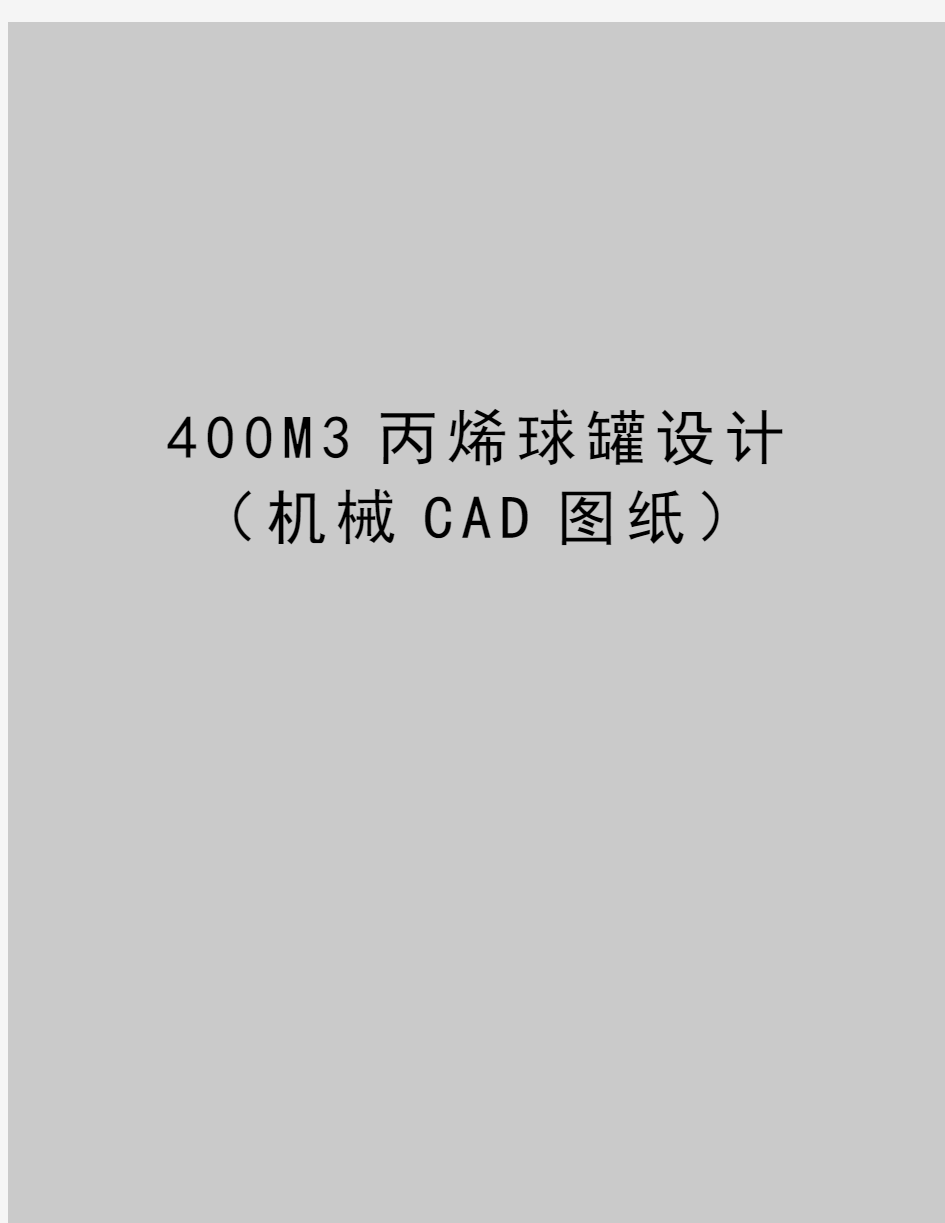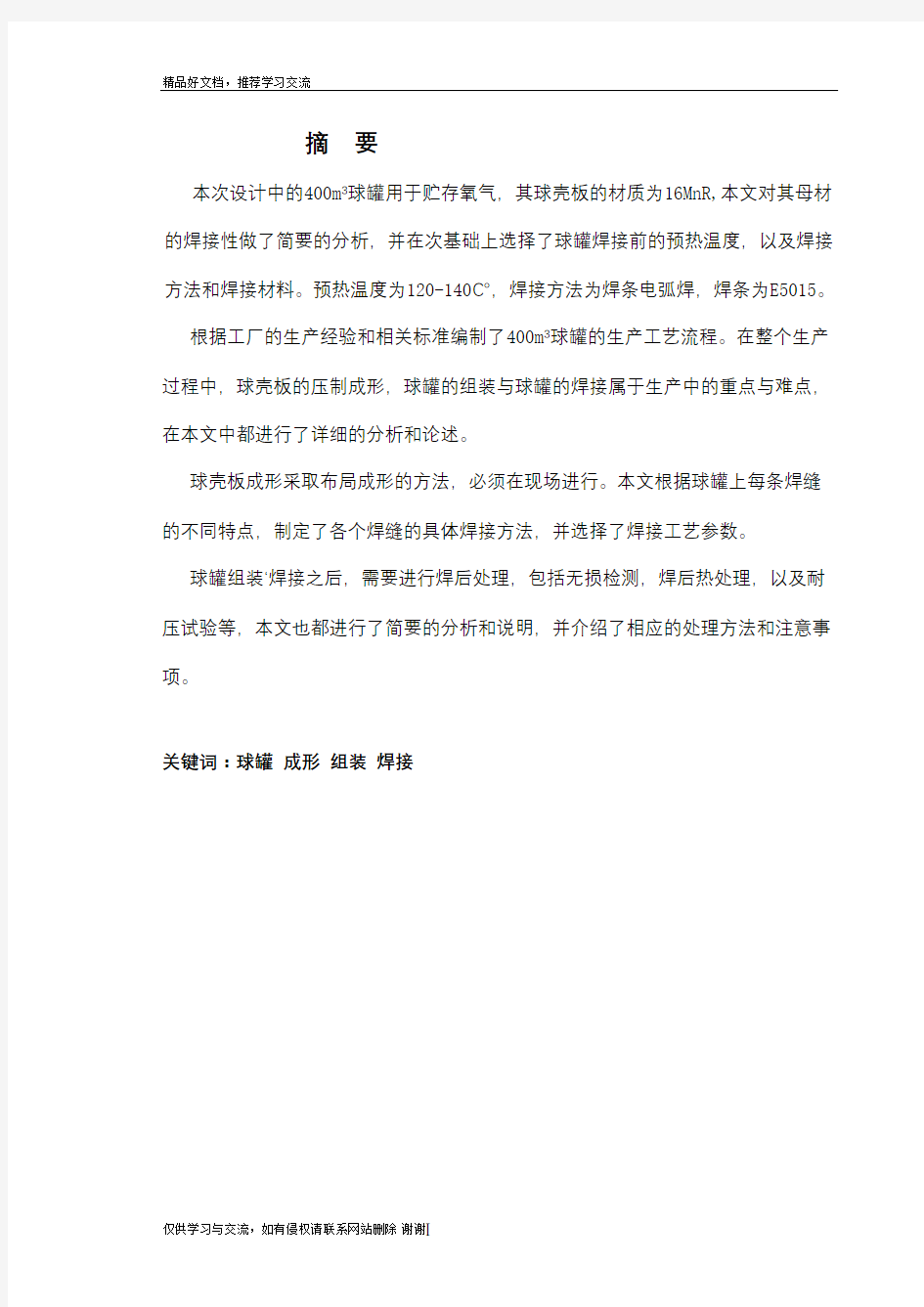最新400M3丙烯球罐设计(机械CAD图纸)


400M3丙烯球罐设计(机械C A D图纸)
摘要
本次设计中的400m3球罐用于贮存氧气,其球壳板的材质为16MnR,本文对其母材的焊接性做了简要的分析,并在次基础上选择了球罐焊接前的预热温度,以及焊接方法和焊接材料。预热温度为120-140℃,焊接方法为焊条电弧焊,焊条为E5015。
根据工厂的生产经验和相关标准编制了400m3球罐的生产工艺流程。在整个生产过程中,球壳板的压制成形,球罐的组装与球罐的焊接属于生产中的重点与难点,在本文中都进行了详细的分析和论述。
球壳板成形采取布局成形的方法,必须在现场进行。本文根据球罐上每条焊缝的不同特点,制定了各个焊缝的具体焊接方法,并选择了焊接工艺参数。
球罐组装‘焊接之后,需要进行焊后处理,包括无损检测,焊后热处理,以及耐压试验等,本文也都进行了简要的分析和说明,并介绍了相应的处理方法和注意事项。
关键词:球罐成形组装焊接
Abstract
The design of the 400m3 spherical container used for store oxygen ,its spherical shell plate material is 16MnR .In this paper, the welding of the base metal was analysed briefly ,and on this foundation ,the preheat temperature before the spherical container for welding ,the welding process ,and the welding material were selected . The preheat temperature is 120-140 ℃,the welding process is the shield metal are welding, the covered electrodes are E5015 .
The produce technologic course of the 400 m3spherical container was compiled according to the experience of the manufacturing plant and related standards .In the entire production process ,the press of forming spherical shell plate ,the installation and welding of spherical container belong to important and difficult in the production . In this paper ,they were carried out a detailed analysis and exposition .
the methods of forming the spherical shell plate was part forming . The of the spherical container was divided two parts, they are the parts installation method ,and it should be conducted at the scene. According to the different character of each weld on the spherical container ,in this paper ,the concrete welding process of every weld was complied ,and the welding procedure parameters were chose .
After the installation and welding of the spherical container ,there need to conduct process when the welding finished ,which include non-destructive testing , post weld heat treatment ,and the pressure test ,and so on .In the paper , they were conducted a brief analysis and exposition ,and were introduced the corresponding resolve methods and attention matters .
Key words :Spherical container forming installation welding
目录
绪论 (1)
1.1球形容器的特点 (1)
1.2球形容器分类 (1)
1.3国内球罐建造情况 (2)
第一章材料选用 (3)
1.1材料的选择原则 (3)
1.2壳体用材料 (4)
1.3锻件用钢 (5)
1.4螺栓、螺母和支撑结构的选材 (6)
1.4.1螺栓螺母的选用 (6)
1.4.2支承结构(支柱、拉杆等)选材 (6)
第二章结构设计 (7)
2.1概述 (7)
2.2球壳设计 (7)
2.3球壳的分带,分块及分角 (8)
2.4纯桔瓣球壳的瓣片设计和计算 (9)
2.4.1瓣片设计 (9)
3.4.2纯桔瓣球瓣的计算 (9)
3.5坡口设计 (15)
3.6支座设计 (16)
3.6.1支座结构 (16)
3.6.2拉杆结构 (16)
3.7人孔和接管 (16)
3.7.1人孔结构 (16)
3.7.2接管结构 (16)
3.8球罐的附件设计 (17)
3.8.1梯子平台 (17)
3.8.2水喷淋装置 (17)
3.8.3隔热设施 (18)
3.8.4页面计 (18)
.8.5压力表 (18)
2.8.6安全阀 (18)
第四章强度计算 (19)
4.1球壳壁厚计算 (19)
4.1.1符号说明 (19)
4.1.2计算各带壳板厚度时的计算压力,最大的物料成装体积 (20)
4.13各带球壳板的厚度计算 (20)
4.2支柱计算 (21)
4.2.1载荷计算 (21)
4.2.2支柱计算 (24)
表4-2B向受力表 (28)
4.2.3 支柱弯矩及偏心率计算 (29)
支柱在操作和水压试验时,在内压力作用下,球壳直径增大,使支柱承受
偏心弯矩和附加弯矩 (29)
a 偏心弯矩 (29)
4.2.4 支柱稳定性验算 (30)
查表得ε0=0.278353 (31)
4.2.5 地脚螺栓计算 (32)
4.3拉杆计算 (33)
4.3.1 拉杆强度计算 (33)
4.3.2 拉杆连接部位计算 (34)
4.4 支柱和球壳连接最低处a点的应力验算 (36)
4.4.1 符号说明 (36)
4.4.2 单项应力计算 (37)
4.4.3 合成应力计算 (38)
4.4.4 强度验算 (39)
4.5 支柱与球壳连接焊缝强度验算 (39)
4.6 支柱间的允许沉降差 (40)
4.7 人孔锻件设计和强度校核 (41)
4.7.1人孔锻件设计 (41)
4.7.2法兰强度校核 (42)
4.7.3法兰外力矩计算 (44)
4.7.4法兰形状系数 (45)
4.7.5 法兰应力计算 (46)
4.7.6应力检验 (46)
第五章工厂制造及现场组装 (47)
5.1工厂制造 (48)
5.1.1 原材料检验 (48)
要了解钢板的使用状态和了解进厂钢板的实际状态是否与使用状态相符。当钢
板检验后证明达到要求时,应在每张钢板上作上适当的标志,并且要求在以后的制造加工过程中仍保持这些标志,以备识别查考。 (48)
5.1.2 瓣片加工 (48)
5.2组装设备及工具 (48)
5.3组装准备 (48)
5.4组装精度的控制 (49)
第六章焊接与检查 (50)
6.1 钢材的可焊性 (50)
6.2 焊接工艺的确定 (50)
6.3焊后热处理 (51)
6.3.1焊后热处理的确定 (51)
6.3.2 焊后热处理 (52)
6.4原材料检验 (52)
6.4.1球罐用钢板的检查和验收 (52)
6.4.2球罐用锻件及其他钢材的检查和验收 (53)
6.5车间制造检验 (53)
6.5.1 焊接检验 (53)
6.5.2 球瓣的检验 (53)
6.5.3 上、下极板的检查 (54)
人孔及其他工艺接管应尽量设置在上、下极板上。由于它们的开孔附近有
很大的毅力集中,因此,在所有接管焊完后应进行消除盈利处理。 (54)
各焊缝间的距离应小于球瓣厚度的三倍,且需大于或等于100mm。除设计
另有要求外,接管中心线应平行或垂直于球壳主轴线,且接管安装的最大
倾斜度≤3mm。 (54)
6.5.4支柱尺寸精度检查 (54)
6.5.5坡口检查 (55)
6.6安装焊接检验 (56)
6.6.1 预组装检验 (56)
6.6.2 焊接质量检验 (56)
6.6.3 焊接工作完成后的检查 (57)
绪论
近几十年来球形容器在国外发展得很快,我国的球形容器建设在七十年代才得到了飞速发展。通常球形容器作为大容积,高压存储容器,在各工业部门中作为液
化石油气(L,P,G),液化天然气(L,N,G),液氨,液氮,液氢,液氧及其他
中间介质的存储。在原子能工业中球形容器还作为安全壳使用。总之随着工业的发展,球形容器的适用范围也就必然会越来越广泛。
由于球形容器多数作为有压贮存容器,故又称球罐。
1.1球形容器的特点
球形容器与常用的圆筒形容器相比具有下列的一些特点:
①球形容器的表面积最小,即在相同容量下球形容器所需钢材面积最小。
②球形容器壳板承载能力比圆筒形容器大一倍,即在相同直径,相同压力下,
采用同样钢板时,求形容器的板厚只需圆筒形容器板厚的一半。
③球形容器占地面积小,且可向高度发展,有利于地表面积的利用。
由于这些特点,再加上球形容器基础简单,外观漂亮,受风面小等原因,是球形容器的应用得到扩大。
1.2球形容器分类
球形容器可按不同方式,如按贮存温度,结构形式等分类。按贮存温度分类:
球形容器一般用于常温或低温。只有极个别的场合,如造纸工业用的蒸煮球等,使用温度高于常温。
(1)常温球形容器如液化石油气,氨,煤气,氧,氮等球罐。一般这类球罐的压力较高,取决于液化气的饱和蒸汽压或压缩机的出口压力。它的设计温度大于-20°C。
(2)低温球罐这类球罐的设计温度低于常温(即≤ -20°C),一般不低于-100°C压力属中等。
